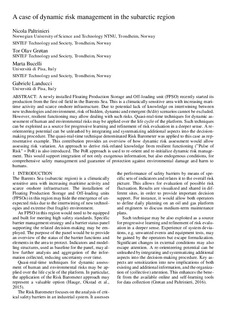A case of dynamic risk management in the subarctic region
Original version
Risk, Reliability and Safety: Innovating Theory and Practice : Proceedings of ESREL 2016 (Glasgow, Scotland, 25-29 September 2016), 809-816 10.1201/9781315374987-121Abstract
A newly installed Floating Production Storage and Off-loading unit (FPSO) recently started its production from the first oil field in the Barents Sea. This is a climatically sensitive area with increasing mari-time activity and scarce onshore infrastructure. Due to potential lack of knowledge on intertwining between new technologies and environment, risk of hidden, dynamic and emergent (h/d/e) scenarios cannot be excluded. However, resilient functioning may allow dealing with such risks. Quasi-real-time techniques for dynamic as-sessment of human and environmental risks may be applied over the life cycle of the platform. Such techniques can be exploited as a source for progressive learning and refinement of risk evaluation in a deeper sense. A re-orienteering potential can be unleashed by integrating and systematizing additional aspects into the decision-making procedure. The quasi-real-time technique denominated Risk Barometer was applied to this case as rep-resentative example. This contribution provides an overview of how dynamic risk assessment would allow assessing risk variation. An approach to derive risk-related knowledge from resilient functioning (“Pulse of Risk" – PoR) is also introduced. The PoR approach is used to re-orient and re-initialize dynamic risk manage-ment. This would support integration of not only exogenous information, but also endogenous conditions, for comprehensive safety management and guarantee of protection against environmental damage and harm to humans
